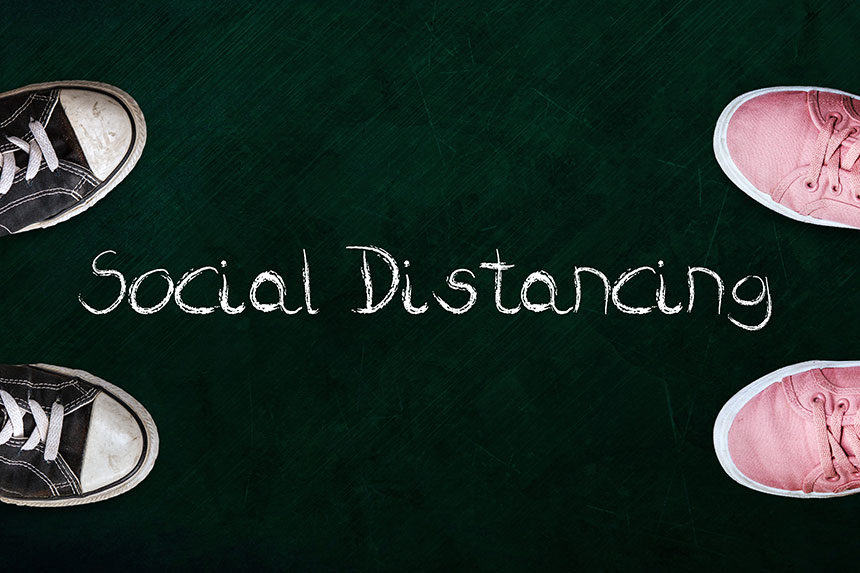I believe in the power of words: they shape how we think, the emotions we feel, the way we act on our world, and how we interact with others.
Given the power of words, I would have thought that our government would have hired linguists, marketing and branding experts, and creative writers when they developed directives for how we should respond to the COVID-19 crisis. But, in my view, it doesn’t appear that they did based on the words chosen to describe the single most impactful directive: “social distancing.”
I find this phrase troubling for two reasons. First, it’s an inaccurate representation of what we are being asked to do. Medical experts aren’t asking us to distance ourselves socially; rather, they are asking us to distance ourselves physically, thus the six feet of separation it wants us to maintain to reduce the chances of spreading COVID-19. The word “social” has nothing to do with maintaining a certain distance from others.
Second, calling this guideline “social” distancing is actually hurting us in ways that are unintended and subtle, yet undeniable. The phrase discourages us from connecting with others at a time when we need to be social (safely, of course) more than ever: communicating, empathizing, caring, supporting, sharing.
As social beings, our need for interactions with others is hard wired into us through eons of evolution. Social contact benefits us psychologically, emotionally, and physically. Social connection makes us feel more comfortable, more relaxed, and safer. Social support has been found to act as an essential buffer against stress.
Is there a more important time for us to stay connected socially than now when, due to the pandemic, we can’t go to work or school, we aren’t supposed to visit family or friends, and have to isolate ourselves in our homes from the outside world?
For many of us, the most meaningful social interactions we have are now mediated through a screen. Thankfully, technology allows us to stay “connected” even during self-quarantine. What a life saver for so many people; imagine if the pandemic had struck pre-internet. Now that is real isolation! Virtual happy hours, coffee klatches, and dating are reasonable facsimiles of social interactions, but they aren’t nearly as satisfying as the real thing. Social connection mediated through a screen is no replacement for real social connection, even if at a distance of six feet.
You may think it’s difficult to socialize with people with the “physical-distancing” directive instructing us to stay apart, but it’s much easier than you think. Every time you leave your home, you have the opportunity to connect with others and allow others to connect with you. You can both give and receive support when we are all feeling isolated and disconnected. At a basic level, connecting helps us feel like we are still a part of something bigger than ourselves when we all can feel like it is us against the world (especially those who live alone).
Here’s what I suggest you do to create social connection and support for ourselves and others during this time of physical distancing. Start with a basic goal: “I’m going to connect with and support people whenever I leave the house.”
When you go for a walk, run, or bike ride, say “hello” or “beautiful day” to everyone you pass (even if they have headphones on. By the way, if you usually wear headphones, try doing without them for the sake of social connection). I do this on my walks with our dog and on my morning runs and everyone always perks up and responds in kind (though some with an initial look of surprise).
When you’re in line outside the grocery store (an all-too-frequent sight these days), don’t just look around or stare at your phone. Instead, use it as an opportunity to strike up a conversation with the person next to you. Start with something as simple as “How are you getting along with all this?” I can assure you that most people will respond with a smile, a breath of relief, and an eagerness to engage.
These days, a big obstacle to connecting with others in spontaneous ways is that just about everyone is wearing a face mask of some sort in public. We can see people’s eyes (though not that well from six feet away), but we can’t see the rest of their faces. We are wired, again through evolution, to read and interpret facial expressions; it helped us decide whether rival tribespeople wanted to have dinner with us or have us for dinner. With face masks on, we don’t know how receptive people will be to connecting, and we worry about being ignored or rebuffed for our efforts. We just don’t know whether the expression under the mask is a scowl (“Not interested”), a smile (“Hello, neighbor”) or a grimace (“I’m feeling so sad today”). But I go under the assumption that we’re all starved for real human contact, even at a distance of six feet, so it’s worth the risk.
During these scary times, our natural reactions are to turn inward, circle our psychological and emotional wagons, and close ourselves off from others to protect ourselves from the invisible, yet potentially deadly, threat of COVID-19. But that is the worst thing to do, so please, do just the opposite. Reach out and connect with those around you. Show others that they are seen, heard, and met by you in this tragic and traumatic once-in-a-lifetime (hopefully) moment. I can assure you that both you and they will be glad you did.
Dr. Jim Taylor is the author of How to Survive & Thrive When Bad Things Happen: Nine Steps to Cultivating an Opportunity Mindset in a Crisis (Rowman & Littlefield, 2019).
Become a Saturday Evening Post member and enjoy unlimited access. Subscribe now




Comments
Only a PHD would make that much of an issue about it, I decided not to finish mine because I saw what it did to people–all of a sudden they were experts on everything. Not quite so.
Bob McGowan Jr – I totally agree with your concerns. Here in York, Pa there seems to be little concern over “social distancing”. 2 local restaurants have been serving inside seated customers in violation of our state’s restrictions. The local DA and PD have stated they will not enforce the Governor’s rules. Most of the customers are older folks who don’t seem to care about their health or the health of other’s.
While most people have been wearing masks, this week they have started to slip below their nose and employees of businesses have them under their chin or in the case of some fast food restaurants, are not wearing them at all.
The 6 foot rule is slowly becoming the 6 inch rule as customers step around the plexiglass shields put up at cash registers. People here are definitely NOT practicing either type of distancing. Social or physical.
The summer is coming and temperatures are already rising among impatient citizens. Churches and beaches will be packed this Memorial Day weekend. Let’s hope this thing doesn’t explode in our faces as some demand their self interpreted or conspiracy theory motivated Constitutional and god-given “rights”.
Dr Taylor has nothing to fear here in York, Pa as social interaction is well underway. If only when unmasked and automatic weapon carrying protesters and illegal restaurateurs are yelling at and threatening our Governor and the health care workers trying to head off the next wave.
I agree with everything you’ve stated in this feature, Dr. Taylor. It IS physical distancing, not social. I don’t expect much though from our nearly ‘brain dead’ government. Today’s linguists, marketing/branding experts and ‘creative’ writers aren’t much smarter either, I’m afraid. Weren’t these the people that completely replaced the word PROBLEMS with the meaningless, patronizing complete denial word “issues” about 25 or more years ago?! Hmmm?
Even before all of this started a few months ago, people were already social-distancing through one tech device or another not wanting to interact with people in their physical presence. Even couples or friends sitting across from one another in restaurants would be having a conversation texting; never looking up from their iPhone, Android, etc. except to occasionally make brief eye contact.
People have been cutting themselves off from one another for a long time now, just as it’s very difficult to try to have a phone conversation with someone, or nearly impossible to talk to a person at a company when you need assistance. This isn’t going to change once things get back to a dark shadows version of what used to be ‘normal’. What will be added is a drastically different physicality aspect to it, upping the ante of a high percentage of anti-social people and divided nation. The restrictive changes coming (from this virus) will likely be taken in stride better by ‘pod people’ rather than fun, social people. We’re the ones who’ll be the most affected by it.
Still, I will take your advice and make more of an effort again. I’m a social person, but even I’VE given up lately on bothering to strike up conversations, which I used to do all the time. I worry about spikes in states that have opened up too much, too soon. Crowded bars in Colorado, crowded beaches in CA., NJ etc. will result in more shutdowns for public health there, and in other states. I hope we’re not looking at a situation of massive mental breakdowns and violence. The summer of ’19 was one of the most violent in American history, and there weren’t any factors even remotely like this going on. I hope the heat doesn’t push a lot of people over the edge. It’s pretty precarious at best; especially with all those newly bought guns over the last couple of months.